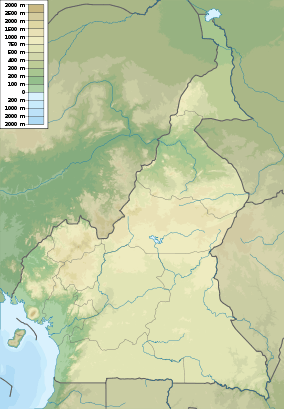Bénoué National Park
| Bénoué National Park | |
|---|---|
|
IUCN category II (national park) | |
 | |
 Location in Cameroon | |
| Location | Cameroon |
| Coordinates | 8°20′N 13°50′E / 8.333°N 13.833°ECoordinates: 8°20′N 13°50′E / 8.333°N 13.833°E |
| Area | 1,800 km2 (690 sq mi) |
| Established | 1968 |
Bénoué National Park is a national park of Cameroon and a UNESCO designated Biosphere Reserve.[1] It is 180,000 ha (440,000 acres) in size. The park has a wide frontage to the Bénoué River,[2] which stretches for over 100 km (62 mi), forming the eastern boundary. The public road to Tcholliré cuts across the northern part of the park. The western boundary is made up of the main road linking the towns of Garoua to the north, with Ngaoundéré to the south.[3] The park can be accessed coming north from Ngaoundéré.[4]
History
In 1932, the area was established as a Faunal Reserve. It was upgraded to a National Park in 1968, and in 1981, it became a Biosphere Reserve.[3]
Geography


The National Park is located in the northeastern part of Cameroon in the Bénoué Department. It lies in the Bénoué savanna belt, a humid savannah woodland area [5]between the cities of Garoua in the north and Ngaoundéré to the south. The main river is the Bénoué River,[2]which stretches for over 100 km (62 mi), forming the eastern boundary. The park's altitude ranges from 250 to 760 m (820 to 2,490 ft) above sea level.The higher elevations are characterized by large rocky massifs, while the undulating plain and forest characterizes the lower sections.[3] Eight hunting reserves, totaling 520,378 ha (1,285,880 acres), surround the park except along the main road.[1]
Flora and fauna
The habitat in Bénoué National Park is characterized by wooded grassland. It includes several types of Sudanian woodland such as Isoberlinia-dominated and other woodland in the south-centre, to shorter, more open, mixed wooded grassland in the north, dry Anogeissus forest, semi-evergreen riparian forest and thickets along the Bénoué and its major affluents.
There is a small population of about 30 lions, which belong to the endangered West African lion population.[6] Elephants, spotted hyena, water buck, warthog and monkeys are also found in the park. The predominant large ungulates in the park are antelope such as the kob, western hartebeest, Lord Derby’s eland and waterbuck, as well as buffalo. The only place in Africa where there is a realistic change to view the Derby eland, Africa's largest antelope, is within Bénoué National Park.[4] The African wild dog is present within the national park, though less common here than in Faro National Park.[7] Bénoué National Park is known for its hippopotamus colonies.[2] Along with hippo, crocodile are common in the rivers.

Bénoué National Park is an Important Bird Area (#CM007) with recent surveys identifying 306 species. In the dry season, sandbars exposed by fluctuating levels of the sandy Bénoué River provide habitat for plover and other waterbirds.[3] Common species include Adamawa turtle-dove, crocodile bird, red-throated bee-eater, red-winged grey warbler, stone partridge, and violet turaco.[8]
Population
The majority of the population within the park is nomadic. There is a loose social structure that park guards and conservationists deal with, taking on roles such as community educators and arbitrators.[1] At least one incident of kleptoparasitism, stealing meat from a lion kill, was documented at Bénoué National Park.[9]
References
- 1 2 3 Nchami, John (September 18, 2010). "Putting the park in the hands of the people". Science in Africa. Archived from the original on 29 November 2010. Retrieved 19 September 2010.
- 1 2 3 "WILDLIFE NATIONAL PARKS". Consulate of the Republic of Cameroon - Sydney, Australia. Retrieved 19 September 2010.
- 1 2 3 4 "BirdLife IBA Factsheet CM007 - Bénoué National Park". BirdLife International. Retrieved 19 September 2010.
- 1 2 Hudgens, Jim; Trillo, Richard (2003). The rough guide to West Africa. Rough Guides. p. 1241. ISBN 1-84353-118-6.
- ↑ Antelopes : global survey and regional action plans. Union internationale pour la conservation de la nature et de ses ressources. Antelope Specialist Group, IUCN. p. 159. ISBN 2-8317-0016-7. Retrieved 19 September 2010.
- ↑ Marjolein Schoe, Hans H. De Iongh, Barbara M. Croes: Humans displacing lions and stealing their food in Bénoué National Park, North Cameroon. African Journal of Ecology. Volume 47, Issue 3, pages 445–447, September 2009.
- ↑ Woodroffe, Rosie; Ginsberg, Joshua Ross; Macdonald, David Whyte (1997). The African wild dog: status survey and conservation action plan. IUCN/SSC Candid Specialist Group. pp. 20–22. ISBN 2-8317-0418-9.
- ↑ "Bird Watching in Cameroon". Retrieved 19 September 2010.
- ↑ Walker, Matt (24 July 2009). "Lions in Cameroon are having their kills stolen from under their noses by hungry villagers.". BBC. Retrieved 19 September 2010.
Further reading
| Wikimedia Commons has media related to Bénoué National Park. |
- Mayakaa, Theodore B. Wildlife Co-Management in the Benoue National Park-Complex, Cameroon: A Bumpy Road to Institutional Development, Elsevier, World Development, Volume 30, Nummer 11, 2002, Seiten 2001 – 2016 (16).
- Mayakaa, Theodore B.; Stigter, Johannes D.; Heitkönig, Ignas M.A.; & Prins, Herbert H.T. A population dynamics model for the management of Buffon’s kob (Kobus kob kob) in the Bénoué National Park Complex, Cameroon, 2001.
- Stark, M. A. "Relationship between fire and basal scarring on Afzelia africana in Benoue National Park", Cameroon African Journal of Ecology, Volume 24 Issue 4, Seiten 263 – 271.